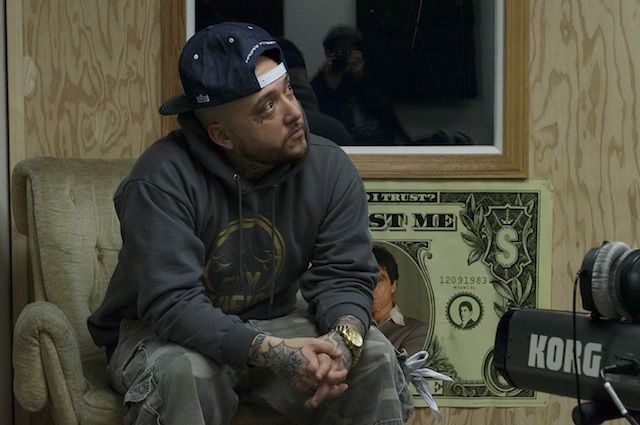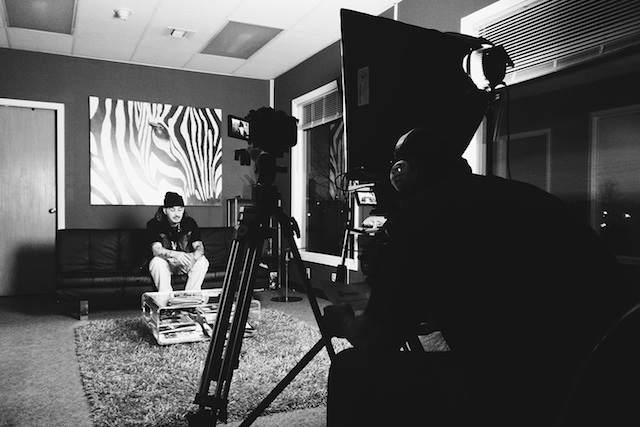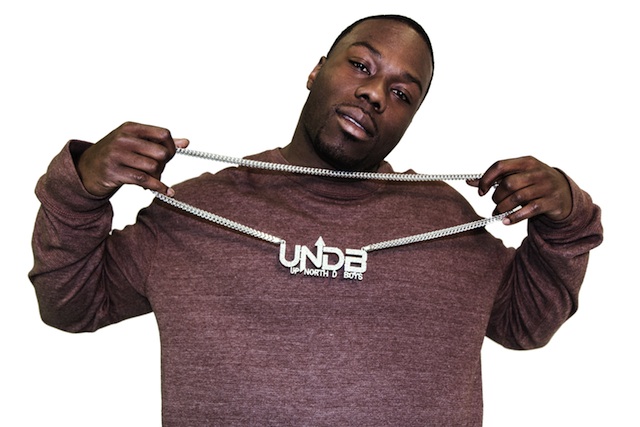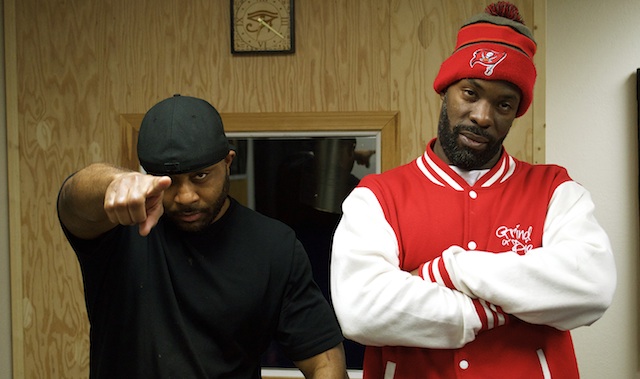Alaska rap crew ODC in their heyday / Photo by Vasco Vea
Three years ago, James Storlie, a.k.a. Tubby, had no idea his throat had been slit. The business end of a box cutter had disconnected nine inches of flesh from the right side of his face and neck, exposing raw muscle and just missing his carotid artery by one inch. Unaware of the severity of his injury, he stood there, in the middle of a cold, downtown street in Anchorage, Alaska, laughing as blood gurgled from his neck. Laughing, not like some crazed, Bruce Campbell caricature but like some shit-faced Joe who doesn’t know how else to react to the absurdity of what just happened.
Videos by VICE
Tubby is a rapper who’s known for his local hip-hop wherewithal and commentary. When he’s on one, you can’t shut the guy up (just check his blog). Today, he’s proving this point by leaving no silence between the two of us as we drive around Anchorage for an hour and a half. In that time, he fills me in on his career—explaining how he got his start in Fairbanks, Alaska, at the age of 15, moved to Anchorage in 2000, and linked up with his longtime producer and engineer Raw Beatzz—and tells me about the rise and fall of early local rap empires, particularly one in which a group of his peers landed at the heart of the largest cocaine bust in Alaska history.
He tells me about guys like Joker the Bailbondsman and Bay Dilla, and connected crews Out Da Cutt (ODC) and Up North D-Boys (UNDB), who helped briefly put Alaska hip-hop on the map with songs like Joker’s “Money In A Ziplock Bag” and Bay’s “That’s My Hood,” as well as an entrepreneurial attitude necessary for musicians coming from such a far-flung locale. He explains how arrests broke those crews and careers up and how the local scene has started bouncing back in recent months, finding renewed energy. But, before dropping into the music, the drugs, the conspiracy, and the arrests, he finishes explaining what happened to him on that cold night back in 2012.

Tubby / Photo by Ryan Earp
His girlfriend was one of the only witnesses to his throat slashing: “She said she saw me and this Samoan guy grabbing onto each other, and some other guy runs up behind me, and, I guess, it looked like he tried to punch me from behind,” Tubby tells me as he ashes a candy-bar-sized blunt out the window of his Chevy Silverado. “But then after he punched me, they both just ran, got into a vehicle and drove off. [My girlfriend] said I turned around—I’m blackout drunk—and I’m laughing, like, ‘what just happened?’ Meanwhile, my cheek is just hanging down.”
Then, maybe as a side effect of recalling his slashing, he starts reminiscing about his own musical influences. “RA The Rugged Man is probably my favorite white rapper,” Tubby says. “His verse on ‘Uncommon Valor’ is my favorite rap verse ever. To this day that shit gives me fuckin’ chills.” The track “Stronger,” in which Tubby addresses his throat slashing, is just one example of the Long Island rapper’s stygian influence: “I’m a one-man army / Fuck you and your thugs / You’re gonna need more than a box cutter / Better hit me with slugs.”
To this day, Tubby has no recollection of the incident and therefore no idea who cut him. “Now, I’m in a situation where these guys tried to take my life. And the part that makes it worse is they could walk up to me right now and I wouldn’t know who they are.” It’s a concern that comes with the territory. For a long time, violence habitually followed the Alaska hip-hop scene—mostly because, by and large, the state’s most prominent rappers were, in some capacity, affiliated with the Alaska drug trade.
“Before I got [a job] up on the Slope, I was dealing dope to pay for my rap shit,” Tubby says, referring to Alaska’s oil-rich North Slope region. “I went on tour with Wu-Tang and was able to do all these shows, and it was all possible because I was a little pilly, drug dealer. One time, finally, after like six months of me sending marijuana from Arizona, the Feds ended up catching one of my packages and they raided my apartment. I had just gotten my first album pressed—I had like 1,000 copies—and they took all my shit, and they gave me a warrant.”
Tubby got off on a technicality—the Feds put the wrong address on the warrant, rendering the raid null and void. The guys Tubby shared a recording studio with, the group collectively known as Out Da Cutt, weren’t so lucky when it came to the Feds knocking on their doors. A lofty drug conspiracy charge, involving 14 co-defendants, warranted the eventual arrests, searches, and seizures.
“[ODC’s] story hasn’t been written fairly,” Tubby says. “That was one thing that I had a grudge with. They made these fools look retarded in the newspaper. And, granted, I get it, from their perspective, [ODC] are the bad guys.”
Continued below…
In more ways than one, ODC was a family business. Its core members consisted of siblings and childhood friends. Terrance Fleming, a.k.a. Bay Dilla, Dilla’s brother Antonio, a.k.a. Wook, Tevoris Carter, a.k.a. Peanut, Demar Moultrie, a.k.a. Duckmane, Terrance Davis, a.k.a. Lil Tee, and Rock Edward Phelps II, a.k.a. Skitzo Scoe—now just known as Scoe—all grew up together. (A common misconception was that Tubby was a member of ODC and UNDB. However, their affiliation only went as far as music.)
“Out Da Cutt was a music label that was founded in the living room of a trap house,” ODC co-founder Wook writes from Fort Worth Correctional Institution. “When me and my brother, Bay Dilla, started ODC, we was just looking for something legal that would provide us with the money to continue living the lifestyle we was used to living without the chance of going to prison. But we was so deep in the streets that we didn’t take it serious at first.”
Wook and Bay formed ODC in 1998. Bay was the main artist, and Wook began as a producer, eventually shifting into more of a business role as the realities of running a record label began to sink in. “Niggas never used to come to the studio to record, or at least they wouldn’t come how I wanted them to come. So, a lot of songs went unfinished and album release dates kept being pushed back,” Wook writes. He ultimately became the group’s manager. “I made sure the mixes were right. I was cutting people with wack verses off hot songs. I was making sure photo shoots went right. I made sure everybody was showing up for meetings and rehearsals. I was just overseeing everything that was happening at the label.”

Bay Dilla / Photo by Vasco Vea
ODC made a big impression on Scoe, who was 11 when it started. He would wear ODC merch and pass out CDs around school. Around that same time, Wook introduced Scoe to his first recording studio. “It was a small home studio, but just being around that studio atmosphere, that’s how I fell in love with music,” Scoe says. He became a founding member of Up North D-Boys (UNDB), the only group under ODC’s label—“We’re the younger version of Out Da Cutt, pretty much,” Scoe tells me. “Loaded,” off the album Str8 Jacket is probably Scoe’s most well known track. If that album is a measure of Scoe’s sound, then it’s best characterized as schizophrenic. With no allegiance to any one hip-hop subgenre, his sound is everywhere, from straight boom-bap tracks like “Curfew” to R&B tracks like “L.O.V.E.,” which sound like they come from a different artist entirely.
Music was always the positive byproduct of ODC and UNDB, though. Drugs were still present, and that lead to antagonism with other crews. “I got shot twice in the back. I was young, like 19 years old, caught in gang violence,” Scoe says. “One bullet is still in me. It’s about an inch, inch and a half away from my spine. One of the bullets went through me before it went into my homeboy. [The doctors] said if it didn’t go through me first, it would’ve went straight through his heart and killed him.”

Scoe / Photo by Alkota Beats
ODC and UNDB were the first Alaskan rappers to really embrace the power of social media. They understood the importance of promoting their music online; they also understood that it was equally as important to have it professionally produced because of its potential reach. So they hired a professional videographer, a guy from Canada named Footage, and flew him to Alaska to produce their music videos. Their music fluctuated from anthemic tracks to hyphy tracks, and they expanded their sound through years living and working on music in Atlanta in the late 00s. Raw lived in the city from 2005 to 2010, getting schooled on the craft or engineering, while Wook and Bay Dilla often traveled there because of family. At one point Bay even had a studio and a second house in Atlanta.
Bay’s videos for “Just Me,” “That’s My Hood,” and the Raw Beatzz-produced “They Know” showcase him and his crew sporting custom jewelry and whipping shitties in expensive cars, while spitting lyrics about a decadent lifestyle funded by drug money. Those videos reached upwards of one and two million views on YouTube. That attention further reinforced ODC and UNDB’s dominance, gave further credence to Bay’s “King of Alaska” pendant that hung from his chain. Their local stardom afforded them the opportunity to open for mainstream acts like Ludacris, Snoop Dogg, E-40, and Too Short, among others. They caught the attention of Ozone Magazine—Dilla was featured in the April 2005 issue. They also caught some very unwanted attention.
“[The] DEA had a major role in the [conspiracy] case. Equal to, if not greater than, [the] FBI,” Assistant U.S. Attorney Frank Russo tells me. Russo prosecuted the case. “The main investigators were local Anchorage police officers assigned to the federal task force. Terrance Fleming, a.k.a. Bay Dilla, was well known in law enforcement circles as a major cocaine trafficker for the past ten years. The fact that UNDB publicized their drug trafficking in their song lyrics didn’t help them avoid law enforcement attention.”
When it came down to it, they were a bunch of dope boys with dreams of becoming rappers. They took the money they made off the streets and reinvested it into studio equipment, appearances, and exposure. From the outside looking in, they were winning. Every up-and-coming Alaskan rapper wanted a piece of the pie. If you weren’t a part of the movement, then you either wanted to be or you were jealous. That is, until 2013 when the Anchorage Police Department (APD), the DEA, and the FBI systematically apprehended members of ODC and UNDB. Scoe and Wook were picked up in Anchorage. Peanut was picked up in New York. A DEA agent, with the help of an APD officer, picked up Bay in Atlanta.
“[During the raid], the authorities stole all [of Bay’s] designer clothes,” Wook writes. “All his Louie, Gucci, Prada, Bally, Tru Religion. I say ‘they stole’ cause none of it was on his confiscation paper. Yet, when our people went over there to clean out the house, which was right after [the authorities] left, all that shit was gone.”

Wook / Photo by Vasco Vea
In court, Bay admitted to being the ringleader of the operation. He pleaded guilty to drug conspiracy, where he admitted to smuggling somewhere between 50 and 150 kilos of cocaine into Alaska between 2009 and 2012—packages were received in the mail from Nevada and Washington and sold in Anchorage and Fairbanks. It’s considered the largest cocaine bust in Alaska history. As part of a plea agreement, Bay forfeited cash, jewelry, and vehicles—all of which was appraised at over $200,000. Computers and hard drives were also confiscated.
“They probably took 50 songs just from me alone,” Scoe says. “Everyone else’s songs were on the hard drives too. So, those were taken as well. They took everything, but everything lost in life can be found again. Except time.”
In a conspiracy case, defendants can only be sentenced to their foresight—“That means you can only get sentenced for what they can prove you could see happening and/or to the degree of your involvement,” Wook says. “That’s why everybody in a conspiracy case gets different sentences, unless they all have the same degree of involvement. Words of advice: Never talk to the agents because, at the end of the day, they can’t help you no matter what they say. It’s all up to the prosecutor.” Scoe, Peanut, Duckmane, and Wook caught federal charges for their roles in the conspiracy—Lil Tee was already serving time prior to the conspiracy case. Scoe was released December 2013 and is back on his music grind. Duckmane was released on July 2015; Peanut’s released date is set for December 2015; Wook’s is February 2017; Bay’s is June 2018.

Joker the Bailbondsman, left, and Raw Beatzz, right / Photo by Ryan Earp
“This is what everybody doesn’t know: It was all the same team,” says Raw, who wasn’t involved in the case and is currently Tubby’s producer. “UNDB started with Joker. If you look at old UNDB pictures, it was [Bay] and Peanut, and Scoe on the side and Joker was in the front. That was before they all went to jail. They got Joker first.”
In 2008, Sean Sullivan, better known as Joker the Bailbondsman, got popped for selling crack to a government informant. Joker’s arrest led to three convictions: two counts of distribution of crack cocaine and one count of attempted distribution of crack cocaine. He received ten years and served about seven and a half. He was released this past February.
Before he got locked up, Joker was arguably the most well known rapper from Alaska. His music videos, six of which experienced continuous play on BET: Uncut, put Alaska hip-hop on the map. In both lyrical content and beats, Joker’s music had a distinct West Coast feel to it. “This is how we roll up north / We’ll cut your life support / Shakedowns when it’s time to extort,” Joker raps over a heavy baseline and G-Funk synths on the track “How We Roll Up North.” Another video for “Uh-huh (Ain’t Nothing Like Money In a Ziploc Bag),” featuring Bizzy Bone of Bone Thugs-n-Harmony, pictures strippers giving lap dances and black-bar-censored b-holes, drug deals on front lawns, and of course money in ziplock bags. As it turned out, Joker’s videos mirrored his reality—a hip-hop lifestyle funded by drug money.
“I like money,” Joker says with a smirk. “I grew up in a middle class family. I didn’t have to sell dope. But everybody I was around was d-boys. So, if my best friend sitting next to me is the man, then I’m gonna get my hustle on. Plain and simple.”
He released his first album, Gather Near, Joker’s Here, in 1997. Although it’s considered a local classic now, at the time, the reaction was lukewarm. But it made an impression on his peers, particularly his childhood friend Wook—the same Wook who would soon co-found Out Da Cutt Records with his brother Bay. “I gave [the album] to Wook, and he’s looking at the CD, like it’s baffling to him,” Joker remembers. “Next thing you know he’s calling me up like, ‘yo, this album is fire. A lot of people are hatin’ on it, but you’re actually doing something. I told him, ‘you guys are out here, wildin’ and actin’ crazy. You should focus that energy on something productive and positive.’”
It that moment, Joker planted a seed that would germinate into ODC. It only took about four months for Wook and his crew to accumulate studio equipment. “[They had] like $20-$30,000 worth of equipment and they didn’t even know where the power button was on the shit,” Joker says with a laugh. “So, I get in there and start helping them out. Shit, within the next four or five months, them boys was making music.” It didn’t take long for the two crews–Joker and ODC-–to collaborate, although nothing official ever came of it. “We never put [those tracks] out,” Joker tells me. “But we have enough to create albums.”

Joker the Bailbondsman’s “Uh-huh” CD (Click for hi-res)
In addition to inspiring ODC, Joker had a record label of his own, Inlet City Records. Joker’s most notable releases include the albums In Real Life, The Bailbondsman, and a compilation called Alaska’s Underground, all of which were released without a major label’s support. The way Joker saw it, he didn’t need a middleman to sell his product when he was more than qualified to do it himself. He worked with distributors to get copies out nationally, and albums were also sold hand-to-hand, through the mail, and at shows. Joker’s momentum was unprecedented—so much that even now, after being away for over seven years, his OG status is still recognized.
Joker’s council and business acumen is revered. It’s not surprising. In 2004, The Source featured an article on Alaska hip-hop titled “Cold Chillin’.” The article embellishes Alaska as a kind of frozen Deadwood dominated by oil, gold, strip clubs, and unsigned hype. However, what the article said is less important than how it came to be. Which, as it turns out, is a perfect tutorial in how Joker gained much of his success in hip-hop.
“I’m the master of cold calls,” Joker tells me. “I just called up The Source—I ended up talking to Kim Osorio—and told her, ‘Hey, I want y’all to come up here and do a write-up about Alaska. I’m paying for first class flights, hotel rooms, lobster and steak dinners.’”

Joker the Bailbondsman / Photo by Ryan Earp
Living in Alaska means to distance yourself from the bulk of Western society. To get off the grid. It can be a black hole from which no amount of effort brings success. Because proximity lends to relevance. And, when it comes to Alaska, hip-hop is relatively irrelevant. This is the bane of the Alaskan hip-hop artist. Only a few crews and record labels have been able to simultaneously unite the local scene and attain commercial success. Joker, ODC, and UNDB are among those few. In more ways than one, they “made it,” however feloniously they did so. When they went down, that unity fractured, leaving a lot of talent without direction. If nothing else, they laid a blueprint for future local rappers and record labels to emulate: what to do and, more importantly, what not to do.
“A lot of people look at Joker and [Bay] in a bad view—this might sound ignorant, especially as a parent—but I look at all the good they did for the local hip-hop scene. And that far outweighs the bad, in my opinion,” Tubby tells me. “All the money that Bay put into the music scene, the artists he brought to Anchorage, the studio he opened for people to learn how to make something from nothing. A lot of people forget all of that shit. Same thing goes for Joker. Joker brought exposure to Alaska before anyone ever did.”
Aside from Scoe and Duckmane, the bulk of ODC and UNDB are still locked up. As they begin to return home, they’ll be making their way back into the studio and, with any luck, away from the streets. While Joker has no intention of getting back into the music industry, he does have his sights set elsewhere. “The music biz sucks,” Joker tells me. “I’m starting a corporation called The International Associates Network. My goal is to take all of the local talent and combine everybody’s expertise into one unit. And we can all help each other and benefit from each other.” Joker used his time in prison to learn as much as he could about other fields. “I never played one hand of cards. I never played dominoes. I would look at [other inmates] and think, ‘You don’t even see what’s attainable outside in the real world,’” Joker tells me. “I wanted to take advantage of the time I had. So I wrote books, developed screenplays for movies, studied iOS software development, learned about intellectual theory, anything I could get a hold of to stimulate my mind.”

Raw Beatzz in the studio / Photo by Ryan Earp
Tubby, on the other hand, has never believed in selling his music, acknowledging that people tune into Tubby more for his stories and personality. “I feel like the whole Tubby brand—my character, my brand of humor—is more popular than my music. I bet you, out of all the people that like my shit, probably 40 percent of them actually follow my music. Which I’m okay with.”
Raw Beatzz is steadily building up a new label called Bad Agenda Records in association with videographer Vasco Vea and producer Alkota Beats (the latter also runs The Drum Broker, arguably the biggest hip-hop sample and distribution business on the Internet). Bad Agenda is spearheading a local hip-hop renaissance: Raw is producing Scoe’s upcoming Breaking Bad EP, while Alkota is busy recruiting and working with other local acts, namely Josh Boots, Phonetic, Keezy (of Sky Div), and most recently a Dominican kid who goes by Wilson La Rabbia Musical.
There’s a new generation of Alaskan rappers who are well aware of the pitfalls of their predecessors. Fast money isn’t always smart money. Yet after years of both successes and setbacks, the songs still endure and Alaska hip-hop is not only still around but spanning generations, ready to come in from the cold.
Cody Liska is the Editor of CRUDE, a magazine dedicated to Alaskan culture.
More
From VICE
-

Rost-9D; NASA / Getty Images -

Screenshot: Shaun Cichacki -

Media Production/Getty Images -

Kari Keone (photo: @spaceghostkari / Instagram)
